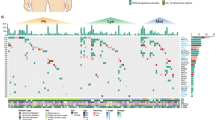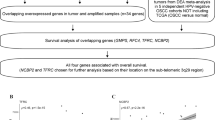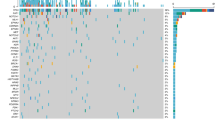Abstract
Using oligonucleotide microarray analysis, THY1, mapping close to a previously defined 11q22–23 nasopharyngeal carcinoma (NPC) critical region was identified as showing consistent downregulated expression in the tumour segregants, as compared to their parental tumour-suppressing microcell hybrids (MCHs). Gene expression and protein analyses show that THY1 was not expressed in the NPC HONE1 recipient cells, tumour segregants, and other NPC cell lines; THY1 was exclusively expressed in the non-tumourigenic MCHs. The mechanism of THY1 gene inactivation in these cell lines was attributed to hypermethylation. Clinical study showed that in 65% of NPC specimens there was either downregulation or loss of THY1 gene expression. Using a tissue microarray and immunohistochemical staining, 44% of the NPC cases showed downregulated expression of THY1 and 9% lost THY1 expression. The frequency of THY1 downregulated expression in lymph node metastatic NPC was 63%, which was significantly higher than in the primary tumour (33%). After transfection of THY1 gene into HONE1 cells, a dramatic reduction of colony formation ability was observed. These findings suggest that THY1 is a good candidate tumour suppressor gene in NPC, which is significantly associated with lymph node metastases.
This is a preview of subscription content, access via your institution
Access options
Subscribe to this journal
Receive 50 print issues and online access
$259.00 per year
only $5.18 per issue
Buy this article
- Purchase on Springer Link
- Instant access to full article PDF
Prices may be subject to local taxes which are calculated during checkout




Similar content being viewed by others
References
Abeysinghe HR, Cao Q, Xu J, Pollock S, Veyberman Y, Guckert NL, Keng P and Wang N . (2003). Cancer Genet. Cytogenet., 143, 125–132.
Abeysinghe HR, Pollock SJ, Guckert NL, Veyberman Y, Keng P, Halterman M, Federoff HJ, Rosenblatt JP and Wang N . (2004). Cancer Genet. Cytogenet., 149, 1–10.
Barda-Saad M, Rozenszajn LA, Ashush H, Shav-Tal Y, Ben Nun A and Zipori D . (1999). Exp. Hematol., 27, 834–844.
Barker TH, Grenett HE, MacEwen MW, Tilden SG, Fuller GM, Settleman J, Woods A, Murphy-Ullrich J and Hagood JS . (2004). Exp. Cell Res., 295, 488–496.
Bonewald L, Ades EW, Tung E, Marchalonis JJ and Wang AC . (1984). J. Immunogenet., 11, 283–296.
Cavallaro U and Christofori G . (2001). Biochim. Biophys. Acta., 1552, 39–45.
Chan KT and Lung ML . (2004). Cancer Chemother. Pharmacol., 53, 519–526.
Cheng Y, Chakrabarti R, Garcia-Barcelo M, Ha TJ, Srivatsan ES, Stanbridge EJ and Lung ML . (2002). Genes Chromosomes Cancer, 34, 97–103.
Cheng Y, Stanbridge EJ, Kong H, Bengtsson U, Lerman MI and Lung ML . (2000). Genes Chromosomes Cancer, 28, 82–91.
Crawford JM and Barton RW . (1986). Lab. Invest., 54, 122–135.
Diaz-Romero J, Gaillard JP, Grogan SP, Nesic D, Trub T and Mainil-Varlet P . (2005). J. Cell Physiol., 202, 731–742.
Fero ML, Randel E, Gurley KE, Roberts JM and Kemp CJ . (1998). Nature, 396, 177–180.
Li LC and Dahiya R . (2002). Bioinformatics, 18, 1427–1431.
Lin CY, Strom A, Vega VB, Kong SL, Yeo AL, Thomsen JS, Chan WC, Doray B, Bangarusamy DK, Ramasamy A, Vergara LA, Tang S, Chong A, Bajic VB, Miller LD, Gustafsson JA and Liu ET . (2004). Genome Biol., 5, R66.
Lung HL, Cheng Y, Kumaran MK, Liu ET, Murakami Y, Chan CY, Yau WL, Ko JM, Stanbridge EJ and Lung ML . (2004). Int. J. Cancer, 112, 628–635.
Protopopov AI, Li J, Winberg G, Gizatullin RZ, Kashuba VI, Klein G and Zabarovsky ER . (2002). J. Gene Med., 4, 397–406.
Qiu GH, Tan LK, Loh KS, Lim CY, Srivastava G, Tsai ST, Tsao SW and Tao Q . (2004). Oncogene, 23, 4793–4806.
Robertson GP, Huang HJ and Cavenee WK . (1999). Mol. Cell Biol. Res. Commun., 2, 1–10.
Tang B, Bottinger EP, Jakowlew SB, Bagnall KM, Mariano J, Anver MR, Letterio JJ and Wakefield LM . (1998). Nat. Med., 4, 802–807.
Xie D, Sham JS, Zeng WF, Lin HL, Che LH, Wu HX, Wen JM, Fang Y, Hu L and Guan XY . (2003). Int. J. Cancer, 107, 896–902.
Acknowledgements
We acknowledge the financial support from the Research Grants Council of the Hong Kong Special Administrative Region, People's Republic of China: Grant numbers HKUST 6113/01M, CA99/00.SC02, and CA03/04.SC01 to MLL, the Agency for Science Technology and Research, Singapore to EL, and the Swedish Cancer Society, the Swedish Research Council, STINT, the Swedish Institute, the Royal Swedish Academy of Sciences and INTAS to ERZ.
Author information
Authors and Affiliations
Corresponding author
Rights and permissions
About this article
Cite this article
Lung, H., Bangarusamy, D., Xie, D. et al. THY1 is a candidate tumour suppressor gene with decreased expression in metastatic nasopharyngeal carcinoma. Oncogene 24, 6525–6532 (2005). https://doi.org/10.1038/sj.onc.1208812
Received:
Revised:
Accepted:
Published:
Issue Date:
DOI: https://doi.org/10.1038/sj.onc.1208812
Keywords
This article is cited by
-
Evolutionary route of nasopharyngeal carcinoma metastasis and its clinical significance
Nature Communications (2023)
-
Stanniocalcin 1 promotes metastasis, lipid metabolism and cisplatin chemoresistance via the FOXC2/ITGB6 signaling axis in ovarian cancer
Journal of Experimental & Clinical Cancer Research (2022)
-
THY1-mediated mechanisms converge to drive YAP activation in skin homeostasis and repair
Nature Cell Biology (2022)
-
Inactivation of ICAM1 inhibits metastasis and improves the prognosis of Ewing's sarcoma
Journal of Cancer Research and Clinical Oncology (2021)
-
CircPLEKHM3 acts as a tumor suppressor through regulation of the miR-9/BRCA1/DNAJB6/KLF4/AKT1 axis in ovarian cancer
Molecular Cancer (2019)



